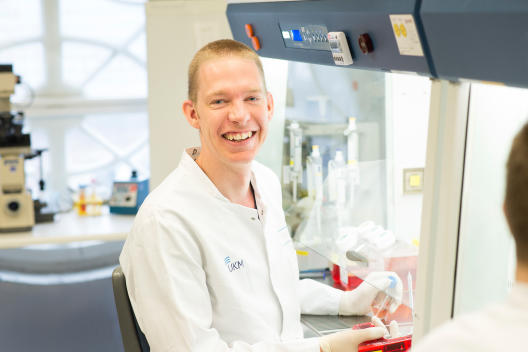A doctor in the lab

Dr. Jonas Lange is happy because he has almost completed his first big research project. For almost two years Jonas Lange exchanged his doctor’s coat for a lab coat in order to investigate the particular properties of lymph node cancer in children. It was made possible by the Cells-in-Motion (CiM) Cluster of Excellence making a position available within a research rotation programme which releases graduated physicians at Münster University Hospital from clinical duties so that they can work on a research project in a CiM working group. In this way, basic research and clinical work come closer together.
Doing additional research work is something that Jonas Lange had already decided to do during his specialist training as a paediatrician. “I hadn’t had an opportunity like this before. But just before I completed my specialist training, I thought, ‘Now or never’,” he says today. He found his research topic through his collaboration with Dr. Birgit Burkhardt, senior physician in the Clinic of Paediatric Haematology and Oncology, and through the support he received from CiM Professor Georg Lenz, who specializes in lymph node cancer in adults. “That was a great combination of topics,” says Jonas Lange. He submitted an application to rotate to a position in Lenz’ working group – and got the approval for the job. “It was the perfect opportunity to get into research. Two years for a big research project was a perfect length of time.”
In his study, Jonas Lange investigated Burkitt’s lymphoma, a malignant tumour which occurs in children relatively often. He examined DNA samples from around 100 patients to see whether they contained any genetic mutations. His aim was to find out which mutations occur in children, and which of these might be relevant in predicting the course of the disease. “It will still be several months, though, till the results can be published,” says Jonas Lange.
He embarked on his job rotation with almost no laboratory experience. The colleagues in the lab gave him a thorough introduction and taught him all the basics in the first few weeks, for example working with cell cultures and pipetting. “There was always somebody on hand that I could ask, and I also benefited from the wide-ranging equipment in the lab,” he says. “After my induction I was able to work independently quite quickly. I had a knowledge of the theoretical basics from my studies.” Jonas Lange is the only physician who is a member of the Young Academy – a network in which junior researchers in the Cluster of Excellence join up to exchange experiences and support one another in their career development.
During the entire period of his job rotation Jonas Lange worked in the lab full-time. “Such a project wouldn’t have been possible alongside everyday work in the hospital,” he explains. After two years he will soon be returning to the hospital, where he wants to benefit from his experience in research. “Working together in the lab is a win-win situation for both sides – for research as well as for practical work in hospital,” he says.

